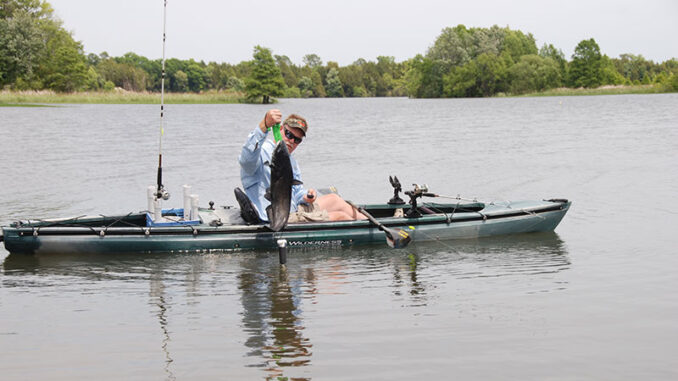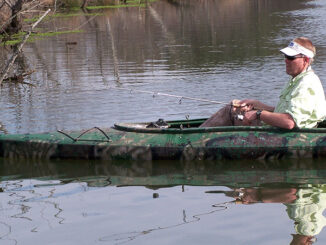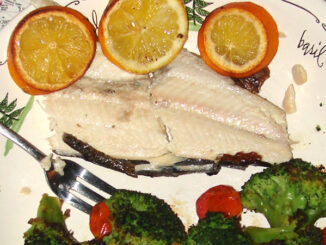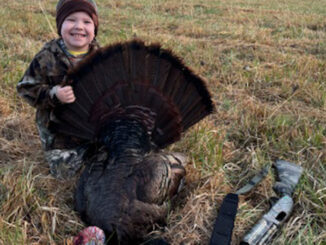
Anchoring is a very important component in kayak fishing and the better you are at it, and the more ways you can employ to position the boat, the better angler you’ll become.
To provide an adjustable anchor point, many kayak anglers use an anchor trolley. Anchor trolleys are specially designed rigging components attached to the outside of the hull, allowing an adjustable tie-off point. The anchor line is clipped or attached to the tie-off point and wheeled between the pulleys to the appropriate point. Imagine one of the old timey clotheslines that big city residents used to string between high rise buildings to dry laundry and you’ll get a better understanding.
Fortunately, kayak anchors don’t weigh nearly as much or take up as much space as conventional boat anchors. All sorts of substitutes, ranging from a 10-pound barbell to a hunk of lead molded into an aluminum can (which fits nicely in a cup holder), will also work.
Shalllow water anchoring in depths of 6 feet or less can be accomplished with an anchor pole. The tip of the pole can be inserted into a ring on the anchor trolley, then pushed straight down into the mud or sand to hold the boat, or most stake out poles come equipped with a short piece of line for a tether that’s attached to the trolley.
If price is no object, that trolling motor set up you paid for to propel the boat can also be used to hold it in place, practically in any water, if it has a feature often referred to as “spot lock.” Such devices work by fixing your position on a built in gps unit, then turning the head of the trolling motor in the opposite direction of the kayak’s drift in order to keep it in one place.
On the low-tech side of things, a simple length of rope can be used to tie or clip the boat to a piece of structure above the surface to hold the kayak in place. The tension of the clip should hold tight enough to keep the boat stationary until it’s time to move to the next spot.
Other accessories include an adjustable pole with a large hook affixed to the end. When fishing in overhead cover such as bridges or trees, the kayak angler can reach up and hook onto something to hold the boat in place.
Go with the flow
Sometimes, remaining perfectly still isn’t desired when kayak fishing. Going with the flow of the current or the wind has its advantages. When fishing tidal regions, either inland or in nearshore waters beyond the breakers, going with the flow of the tide is the best course of action with the angler using a rudder system to guide the boat in the right direction.
The same can be said when fishing inland rivers or the upper ends of impoundments where current dictates much about the fishing. Going with the flow, casting to likely targets along the way is a good fishing strategy. At times, the current or tidal flow might be a bit fast to allow the kayak angler to thoroughly fish an area or get baits down deep into the current if that’s where the fish are.
Crawl it
Some kayak anglers will pack along a length of stout chain and deploy the chain from the rear of the kayak or on a length of rope. Chain in the 3/8- or ½-inch size will produce considerable drag when tethered behind the boat. Because it’s just chain with no attachments, it tends to crawl across the bottom without snagging, even in dense underwater structure. Chain that is coated in rubber or plastic will decrease the amount of noise it makes when deployed and stowed in the boat.

If the water depth is consistent across the area to be fished, the speed of the boat can be somewhat adjusted by how much chain is let out. For example, allowing 6 feet of chain would produce a slower drift rate than allowing 3 feet of chain to drag across the bottom. This is controlled by simply letting more or less chain out during the drift.
A downside to dragging chain behind a kayak in current is the possibility of disrupting the bottom contour and/or spooking fish on the first pass. If the contour is rock or shale and only one pass is desired, then the chain might be the answer.
Sock it to ‘em
For deeper water or fragile bottom, an alternative to slow the speed of the drift is by deploying a drift sock. Drift socks resemble a funnel when properly deployed in current and will dramatically decrease the speed of the drift dependent on the size of sock used.
A wind sock with a 60-inch opening will slow the drift considerably more than a 48-inch model. Drift socks are sized based on the length of the boat, starting at around 14 feet, so the smallest size available is typically the best for kayak usage.
One of the most valuable forms of boat positioning is integrated into the angler. The use of the paddle, pedal, or both in conjunction with the conditions is a valuable skill to have when kayak fishing. The savvy angler keeps track of wind and current direction, as well as speed, and uses these to his or her advantage. Knowing when and where to duck behind large structural items, in order to make a few casts into current seams, becomes second nature with time and practice.
Once the angler has mastered these basic boat positioning skills, then integrating additional gear into the mix is all that is needed to complete your quest to be a proficient and well-rounded kayak angler.





Very thorough article so I was surprised when neither of my systems were mentioned. I run a Micro Power Pole off the back and an Anchor Wizard off the front. This allows me to hold my spot by deploying one or both based on conditions. Also, when I deploy both I can use the current and wind to adjust my position by letting a little line out at a time to sweep an area. It also means if I’m drifting and a big Red takes me on a sleigh ride, I’m just a button push away from locking her down.